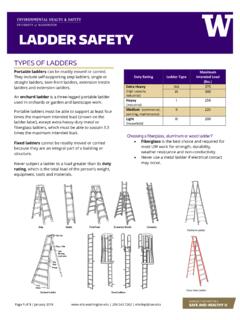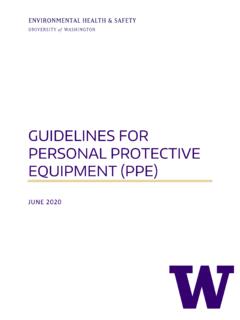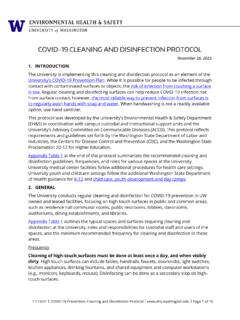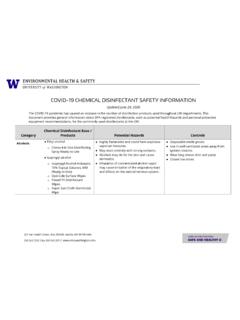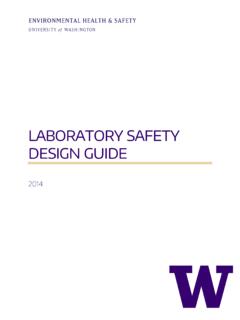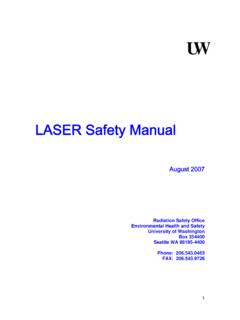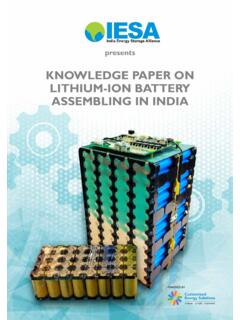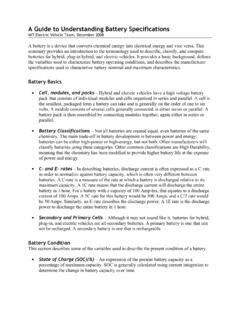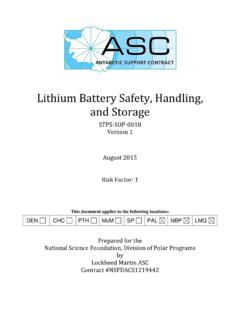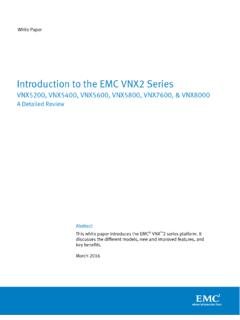Transcription of LITHIUM BATTERY SAFETY - University of Washington
1 Page 1 of 6 | November 2021 | | LITHIUM -Ion BATTERY SAFETY LITHIUM BATTERY SAFETY SUMMARY LITHIUM batteries have become the industry standard for rechargeable storage devices. They are common to University operations and used in many research applications. LITHIUM BATTERY fires and accidents are on the rise and present risks that can be mitigated if the technology is well understood. This paper provides information to help prevent fire, injury and loss of intellectual and other property. Background LITHIUM -ion BATTERY hazards Best storage and use practices LITHIUM BATTERY system design Emergencies Additional information BACKGROUND LITHIUM batteries have higher energy densities than legacy batteries (up to 100 times higher).
2 They are grouped into two general categories: primary and secondary batteries. Primary (non-rechargeable) LITHIUM batteries are comprised of single-use cells containing metallic LITHIUM anodes. Non-rechargeable batteries are referred to throughout the industry as LITHIUM batteries. Secondary (rechargeable) LITHIUM batteries are comprised of rechargeable cells containing an intercalated LITHIUM compound for the anode and cathode. Rechargeable LITHIUM batteries are commonly referred to as LITHIUM -ion batteries. Single LITHIUM -ion batteries (also referred to as cells) have an operating voltage (V) that ranges from LITHIUM ions move from the anode to the cathode during discharge.
3 The ions reverse direction during charging. The lithiated metal oxide or phosphate coating on the cathode defines the chemistry of the BATTERY . LITHIUM -ion batteries have electrolytes that are typically a mixture of organic carbonates such as ethylene carbonate or diethyl carbonate. The flammability characteristics (flashpoint) of common carbonates used in LITHIUM -ion batteries vary from 18 to 145 degrees C. Page 2 of 6 | November 2021 | | LITHIUM -Ion BATTERY SAFETY There are four basic cell designs; button/coin cells, polymer/pouch cells, cylindrical cells, and prismatic cells. (see Figure 1). The most common designs prevalent in academic and research use include polymer/pouch cells typically used in iPods, tablets and cell phones.
4 Cylindrical cells incorporate the similar design parameters that have been the standard for alkaline cells for years (A, AA, AAA, C, and D cells). Prismatic cells are thin, square cells with hard steel cases. Prismatic cells are typically used in cell phones and thin, laptop computers. Other than cell phones and tablets, most portable electronic/electrical devices operate above the normal operating voltage of single LITHIUM -ion batteries ( ). For such devices, numerous cells connected in packs provide the desired voltage and capacity. Connecting cells in parallel increases pack amperage and discharge capacity while connecting cells in series increases pack voltage.
5 As an example, a 24V LITHIUM -ion BATTERY pack typically has six cells connected in series . Many BATTERY packs have built-in circuitry used to monitor and control the charging and discharging characteristics of the pack . As an example, circuitry will automatically manage the charging when the pack cells reach and/or if the temperature exceeds a preset value. The circuits will shut down the pack if the cells discharge below a preset value ( , per cell). The cylindrical cell (identified by 18650 ) is similar in size and shape to an AA BATTERY . It is the workhorse of the LITHIUM -ion BATTERY industry and is used in a majority of commercially available BATTERY packs.
6 Examples are shown in Figure 2. Figure 2. BATTERY / BATTERY pack Examples LITHIUM -ION BATTERY HAZARDS LITHIUM -ion BATTERY fire hazards are associated with the high energy densities coupled with the flammable organic electrolyte. This creates new challenges for use, storage, and handling. Studies have shown that physical damage, electrical abuse such as short circuits and overcharging, and exposures to elevated temperature can cause a thermal runaway. This refers to rapid self-heating Figure 1. Typical Cell Designs Page 3 of 6 | November 2021 | | LITHIUM -Ion BATTERY SAFETY from an exothermic chemical reaction that can result in a chain reaction thermal runaway of adjacent cells.
7 Manufacturer s defects such as imperfections and/or contaminants in the manufacturing process can also lead to thermal runaway. The reaction vaporizes the organic electrolyte and pressurizes the cell casing. If (or when) the case fails, the flammable and toxic gases within the cell are released. The severity of a runaway BATTERY reaction relates to the buildup and release of pressure from inside of the cell. Cells with a means of releasing this pressure ( , pressure relief vents or soft cases) typically produce less severe reactions than cells that serve to contain the pressure and rupture due to high pressure ( , unvented cylindrical cells). As a result, the cell construction can be a major variable pertaining to the severity of a BATTERY incident.
8 The resulting reaction can look anywhere from a rapid venting of thick smoke ( , smoke bomb/smoker), to a road flare, to a steady burn, to a fireball to an explosion. See Figure 3. Smokers Flares Burners Fireballs Explosions Figure 3. General BATTERY Reactions The severity of the reaction is generally a function of a number of parameters including BATTERY size, chemistry, construction and the BATTERY state of charge (SOC). In almost every significant BATTERY reaction, the same hazardous components are produced, flammable by-products ( , aerosols, vapors and liquids), toxic gases and flying debris (some burning), and in most instances, sustained burning of the electrolyte and casing material.
9 During a venting reaction ( , no ignition of the vented products), the products consist primarily of electrolyte constituents. For most batteries, the products typically consist of carbon dioxide (CO2), carbon monoxide (CO), hydrogen (H2) and hydrocarbons (CxHx). These gases are flammable and present fire and explosion risk. For the burning scenario, the electrolyte burns efficiently producing primarily carbon dioxide (CO2) and water (H2O) as the by-products. For most batteries, the products typically consist of CO2 and water vapor. The burning reaction also tends to liberate the fluorine from the LITHIUM salt (typically LiPF6) dissolved in the electrolyte. The fluorine typically reacts with hydrogen to form hydrogen fluoride (HF).
10 HF production is also proportional to the electrical energy stored in the cell/ BATTERY and can result in dangerous concentrations. HF reacts with the water vapor produced during the reaction and/or with the mucus membranes in the human body ( , eyes, nose, throat, lungs) and becomes hydrofluoric acid. BEST STORAGE AND USE PRACTICES Procurement Purchase batteries from a reputable manufacturer or supplier. Avoid batteries shipped without protective packaging ( , hard plastic or equal). Page 4 of 6 | November 2021 | | LITHIUM -Ion BATTERY SAFETY Inspect batteries upon receipt and safely dispose of damaged batteries. Storage Store batteries away from combustible materials.
